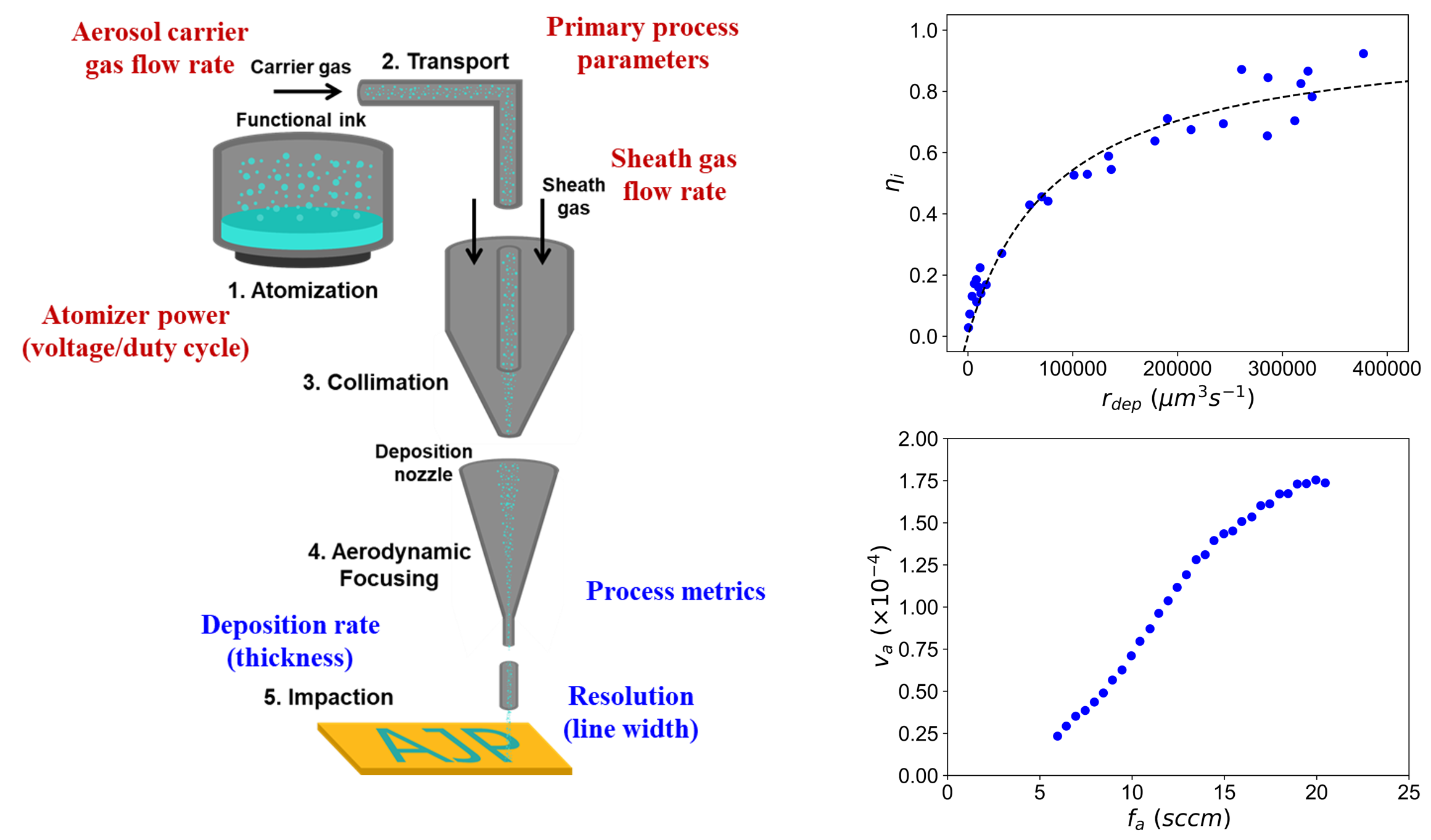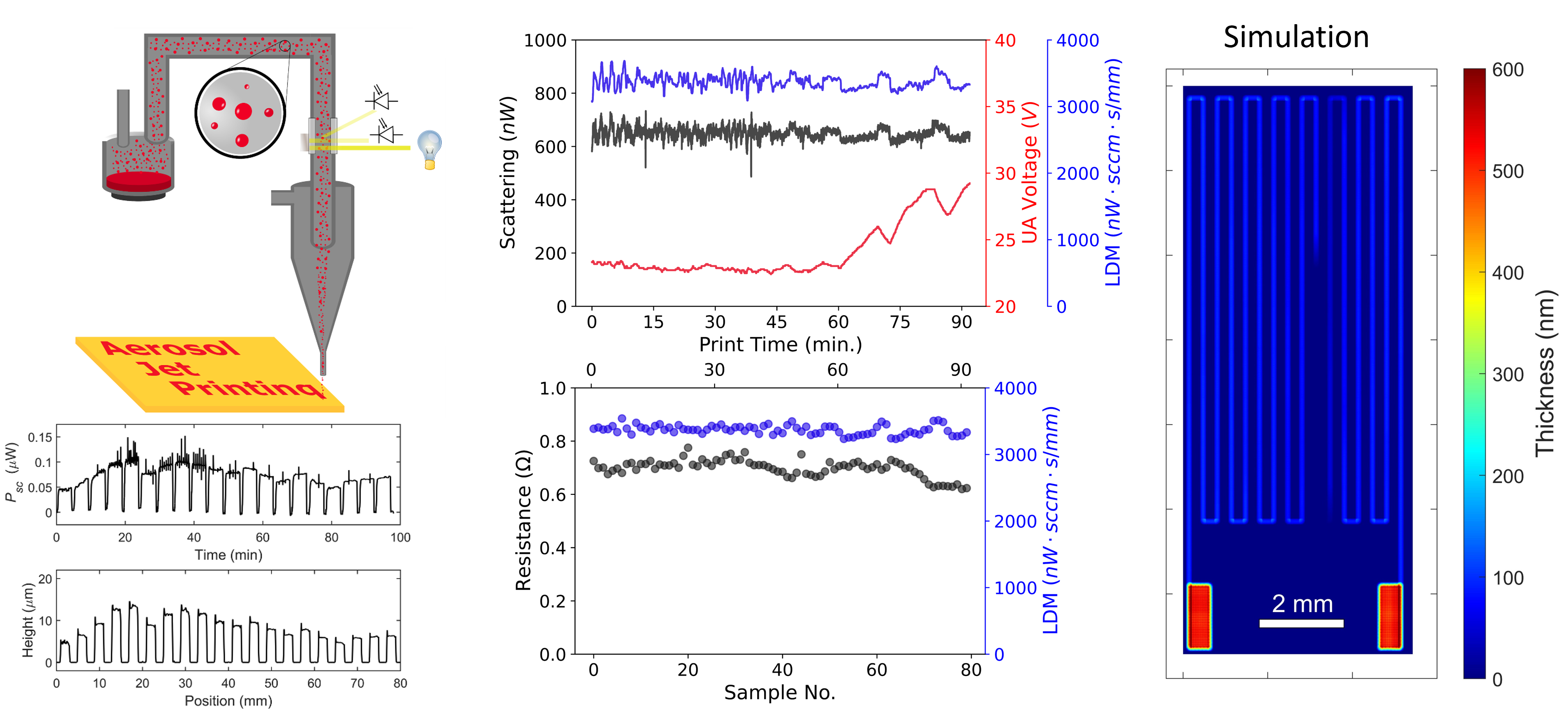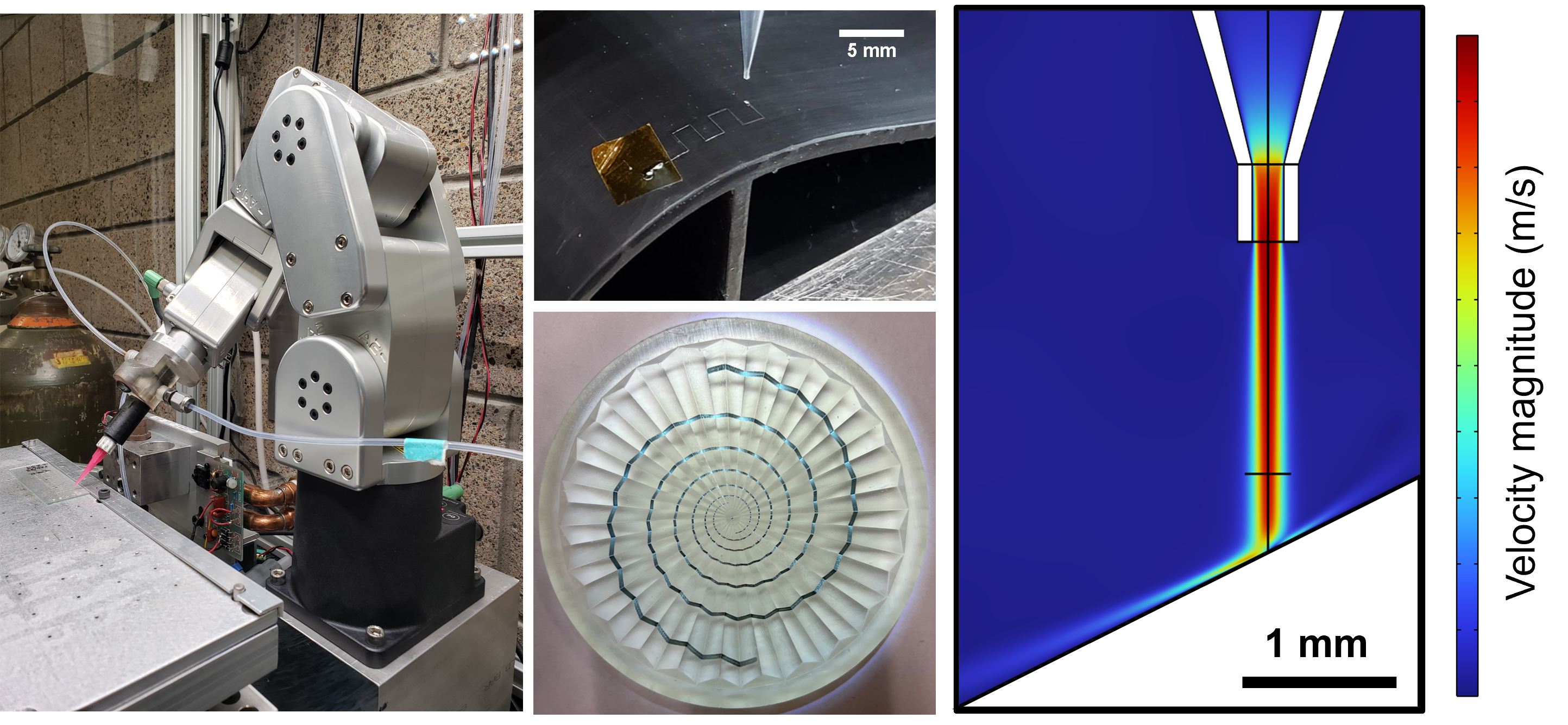Research
Home | People | Research | Publications | Sponsors
Printed hybrid electronics and aerosol jet printing
Our research is focused on additive manufacturing technologies for electronic materials. We specifically focus on a digital printing method called aerosol jet printing, which deposits micron-scale droplets of functional liquid inks to produce fine (~20-50 micron) patterns. This can be used to fabricate electronic devices (e.g., sensors, antennas), print wiring to manufacture more complex circuits include conventional microelectronics and passive electronic devices, and target more advanced structures including high aspect ratio pattern and composition gradients. Our work in aerosol jet printing (AJP) spans efforts to understand the physics of the printing process, and thus more rationally approach ink formulation and modification of the printing system; improve manufacturing reliability through unique process monitoring and control technologies; fabricate electronics on curved 3D surfaces by exploiting the high nozzle-surface offset during printing and digital motion planning; and develop new materials, including gradient patterning with multiple materials. Additional details related to each of these four core topics is included below.
Aerosol jet printing process fundamentals
We aim to establish a holistic framework to understand the physics of AJP, which can provide guidance for material development, process parameter optimization, and printing system design. This provides a versatile foundation for other research efforts, and is based on tailored experiments, computational modeling, and theory-driven analysis.

(Left) Schematic of aerosol jet printing, highlighting primary process parameters and metrics. (Right) Quantitative estimates of impaction efficiency and aerosol volume fraction derived from fundamental process science experiments to develop models for process physics.
Representative publications:
Tafoya R.R.; Secor E.B. Understanding Effects of Printhead Geometry in Aerosol Jet Printing. Flex. Print. Electron. 2020, 5(3):035004. https://doi.org/10.1088/2058-8585/aba2bb
Tafoya R.R.; Secor E.B. Understanding and Mitigating Process Drift in Aerosol Jet Printing. Flex. Print. Electron. 2020, 5(1):015009. https://doi.org/10.1088/2058-8585/ab6e74
Secor E.B. Guided Ink and Process Design for Aerosol Jet Printing Based on Annular Drying Effects. Flex. Print. Electron. 2018, 3(3):035007. https://doi.org/10.1088/2058-8585/aadffd
Secor E.B. Principles of Aerosol Jet Printing. Flex. Print. Electron. 2018, 3(3):035002. https://doi.org/10.1088/2058-8585/aace28
Process monitoring and control for aerosol jet printing
Process reliability is a key requirement for practical applications of AJP. We have developed an in-line process monitoring technology based on light scattering to estimate the deposition rate in real time during printing. By integrating this measurement with the printer control software, we have demonstrated closed loop control during printing to mitigate long-term process drift. Moreover, correlating this measurement with the spatial position of the printer allows a rudimentary simulation of the printed part for quality monitoring. Finally, this measurement provides critical insight on mechanisms happening within the printhead, thus providing a unique tool to advance fundamental process studies.

(Left) Schematic of light scattering measurements for real-time process monitoring during printing, along with proof of concept data. (Center) Demonstration of closed-loop control for aerosol jet printing via automated modulation of the atomizer voltage to maintain a stable print output. (Right) Demonstration of print simulation based on actual process data, mapping the expected thickness spatially within a printed pattern.
Representative publications:
Rurup J.D.; Secor E.B.A Real-Time Process Diagnostic to Support Reliability, Control, and Fundamental Understanding in Aerosol Jet Printing. Adv. Eng. Mater. 2023, 2301348. https://doi.org/10.1002/adem.202301348.
Rurup J.D.; Secor E.B. Predicting Deposition Rate and Closing the Loop on Aerosol Jet Printing with In‐Line Light Scattering Measurements. Adv. Eng. Mater. 2023, 2201919. https://doi.org/10.1002/adem.202201919.
Secor E.B. Light Scattering Measurements to Support Real-Time Monitoring and Closed-Loop Control of Aerosol Jet Printing. Additive Manufacturing 2021, 44:102028. https://doi.org/10.1016/j.addma.2021.102028
Tafoya R.R.; Cook A.W.; Kaehr B.; Downing J.R.; Hersam M.C.; Secor E.B. Real-Time Optical Process Monitoring for Structure and Property Control of Aerosol Jet Printed Functional Materials. Adv. Mater. Technol. 2020, 5(12):2000781. https://doi.org/10.1002/admt.202000781
Conformal printed electronics
A key opportunity for aerosol jet printing, afforded by its tolerant nozzle-surface standoff distance (~1-5 mm), is the ability print on nonplanar surfaces. While a powerful capability in principle, this introduces greater complexity for motion planning and alignment. We have developed a printing system mounted on an articulated robotic arm to address printing challenges for large-area, low-curvature surfaces, with additional utility for some constrained geometries. This effort includes hardware and method development, fundamental studies of aerosol transport and deposition unique to this configuration, and computational approaches to streamline motion planning.

(Left) Aerosol jet printing system based on an articulated robot arm. (Center) Demonstration of conformal patterns printed on nonplanar surfaces. (Right) Computational model of the aerosol jet in an oblique configuration.
Representative publications:
Jignasu, A.; Rurup, J.D.; Secor E.B.; Krishnamurthy, A.Conformal Aerosol Jet Printing Using a 3-Axis Printer. Manuf. Lett. 2023, 35, 523-528. https://doi.org/10.1016/j.mfglet.2023.08.011.
Materials development and multimaterial printing
Formulating inks for aerosol jet printing will enable new applications for printed circuits, sensors, and other devices. The fabrication capabilities, along with constraints on ink formulation, are compounded during multimaterial printing with in-line mixing, which has been demonstrated for combinatorial printing, gradient material fabrication, and in situ mixing of reactive components.

(Left/Center) Aerosol jet printing graphene micropillars with high aspect ratio, achieved by tailoring the ink formulation to effect rapid change in rheology during printing. (Right) Gradient in conductivity across a multimaterial printed film containing graphene and carbon nano onions with a varying ratio.
Representative publications:
Gamba, L.; Razzaq, M.E.A.; Diaz-Arauzo S.; Hersam M.C.; Bai, X.; Secor E.B. Tailoring Electrical Properties in Carbon Nanomaterial Patterns with Multi-Material Aerosol Jet Printing. ACS Appl. Mater. Interfaces 2023, https://doi.org/10.1021/acsami.3c15088.
Gamba, L.; Diaz-Arauzo S.; Hersam M.C.; Secor E.B.Aerosol Jet Printing of Phase Inversion Graphene Inks for High Aspect Ratio Printed Electronics and Sensors. ACS Appl. Nano Mater. 2023, acsanm.3c04207. https://doi.org/10.1021/acsanm.3c04207.
Gamba, L.; Lajoie, J.A.; Sippel, T.R.; Secor E.B.Multi-Material Aerosol Jet Printing of Al/CuO Nanothermites for Versatile Fabrication of Energetic Antennas. Adv. Funct. Mater. 2023, 2304060. https://doi.org/10.1002/adfm.202304060.